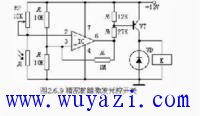The photo-control switch circuit with the photoresistor as the core component with relay control output has many forms, such as self-locking bright excitation, dark excitation and precision bright excitation, dark excitation, etc. Several typical circuits are given below. Figure (2) is a simple dark excitation relay switching circuit. The working principle is: when the illuminance drops to the set value, the VT1 is turned on due to the rising resistance of the photoresistor, and the excitation current of VT2 makes the relay work, the normally open contact is closed, the normally closed contact is disconnected, and the external circuit is controlled.
The figure below is a precise dark-excitation time-delay relay switching circuit. The working principle is as follows: when the illuminance drops to the set value, the potential of the anti-phase terminal of the operational amplifier IC rises due to the rise of the resistance value of the photoresistor, and the output thereof excites the VT to be turned on, the excitation current of the VT causes the relay to work, and the normally open contact closes. The normally closed contact is disconnected to realize the control of the external circuit. 
Comcn Electronics Limited , https://www.comencnspeaker.com
![<?echo $_SERVER['SERVER_NAME'];?>](/template/twentyseventeen/skin/images/header.jpg)